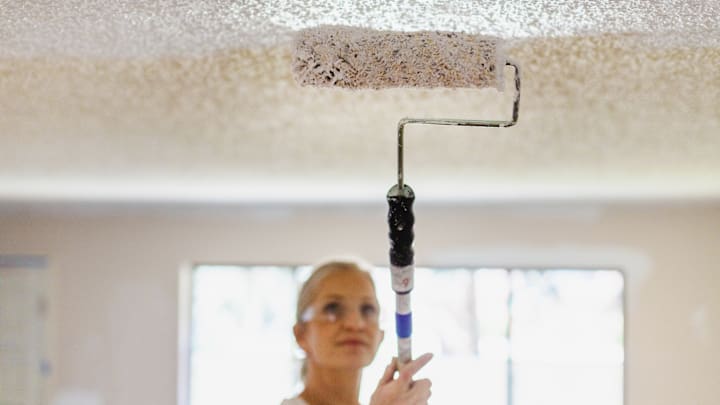In the 1987 Coen Brothers film Raising Arizona, H.I. McDunnough (Nicolas Cage) is fighting for his life against a home intruder (John Goodman). Raising his clasped hands in the air to bring them down over his assailant’s back, McDunnough lets out a yelp: He’s scraped his knuckles against the unforgiving surface of his popcorn ceiling.
The pain of this outdated decorating trend is more than just physical: The lumpy, speckled finish is now largely considered an eyesore, and anyone purchasing an older home is probably going to get busy removing it. But why did it ever get popular in the first place?
The Origin of Popcorn Ceilings
During the1950s housing boom that followed World War II, home builders and consumers needed to expedite the postwar construction process any way they could in order to meet demand. One simple solution for finishing off a room was the popcorn ceiling (also known as a stucco or acoustic ceiling), a sticky spray application borrowed from England that created texture without the need for costly and time-intensive finishing techniques. A regular ceiling might need to be sanded, plastered, and painted. With a popcorn finish, one application was all it took. (Despite the name, it looks less like popcorn and more like the lunar surface.)
You May Also Like:
- The Fascinating Reason Why Some Houses Have Two Front Doors
- What Are Those Little Doors in Old Houses For?
- The Most Valuable Home Styles in the U.S.
Add Mental Floss as a preferred news source!
Saving on construction time wasn’t the only benefit. Owing to its three-dimensional surface, a popcorn ceiling could easily hide imperfections in the underlying material. It was also good for sound dampening, which was important to growing families as well as apartment dwellers who might have upstairs neighbors.
There was just one problem. As the century wore on, both residents and environmental agencies grew increasingly concerned about an element often found in building materials: asbestos.
The Danger of Popcorn Ceilings

For a portion of the 20th century, a number of homes incorporated asbestos, a natural silicate fiber that can cause lung damage and eventually cancer when inhaled. (The tiny “hairs” of the material are difficult for lungs to expel.) Asbestos could be found in plumbing insulation, attic insulation, flooring tile, and other elements. Naturally, it was also used in popcorn ceilings, which consisted of a combination of vermiculite and asbestos to help create the bumpy look.
By the 1970s, building regulations had banned asbestos from new construction and devised careful remediation steps if the material needed to be removed from a property.
Popcorn ceilings didn’t have to be made with asbestos. Other material, like Styrofoam, could be used. But owing to the association, changing tastes, or both, the design began to fall out of favor in the 1980s. If you come across one, it’s likely to be a relic of another era.
But should you be worried about possible health risks? Not unless you want to remove it.
Removing Popcorn Ceilings

Simply being near a popcorn ceiling isn’t likely to be an issue. Asbestos is hazardous when it’s disturbed and becomes airborne, not when it’s affixed to a surface. A kitchen tile, for example, that contains asbestos isn’t going to harm you, but prying it up from the floor and cracking it is a different story.
Suppose you bought a home that requires remodeling and it sports a bumpy ceiling. The first thing you should do is get it tested: While some experienced contractors might suspect asbestos on sight, it can’t be confirmed on visual inspection alone. Environmental companies can assess whether any building materials present a health hazard by taking small samples and looking for problematic materials. (Asbestos additives were sold through the 1980s, meaning any home built prior to 1990 could conceivably have it somewhere on the property.)
Popcorn Ceilings vs. Textured Ceilings |
|---|
A popcorn ceiling is a type of textured ceiling, which is any ceiling that uses application techniques to create a pattern. Examples include knockdown texture, comb texture, and sand swirl texture. Some types offer better sound dampening qualities, while others can add depth to smaller rooms. |
If you have an asbestos-laden ceiling, you would need to enlist the services of a specialized remediation company, which would remove it while taking care not to let contaminants enter the air or the rest of the home. They’ll also have an idea of the proper method of disposal, as local municipalities might not permit hazardous materials to be placed with regular trash.
Unless your popcorn ceiling is actively crumbling or you have water damage, it’s probably safe to just leave it alone. But if it isn’t full of asbestos, then removing it could be a do-it-yourself job. Some advocate for wetting down the “bumps” with water and scraping them off, but this won’t work if the ceiling has been painted. Other solutions can strip both paint and popcorn texture, but they’re messy and potentially dangerous if not used properly—so always check and follow the directions.
If all that labor doesn’t sound appealing, just tell people you’re going for a midcentury design look and wait it out. Like most trends, it’ll probably make a comeback.
